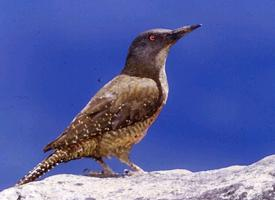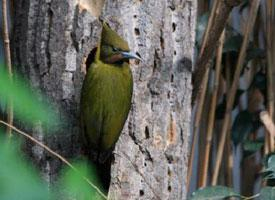
Poids et mesures
| Longueur | de 22 à 30 cm |
|---|
Description de l'animal
The Ground woodpecker (Geocolaptes olivaceus) is a distinctive species of bird, belonging to the woodpecker family Picidae. This bird is endemic to the southern regions of Africa, predominantly found across the grasslands, fynbos, and karoo habitats of South Africa. Unlike its tree-dwelling cousins, the Ground woodpecker exhibits unique adaptations that make it more suited to a terrestrial lifestyle, a rarity among woodpeckers.Physically, the Ground woodpecker is a medium-sized bird, measuring about 20 to 23 cm in length. It has a robust build with a straight, strong bill adapted for its feeding habits. The plumage of the Ground woodpecker is primarily a dull olive-brown color, which serves as excellent camouflage against the earthy tones of its habitat. Its underparts are paler, with a distinctive white throat that stands out against its darker face and upper body. One of its most striking features is the bright red patch located on the lower abdomen, which is more pronounced in males than in females. The bird's tail is stiff and supports it as it forages on the ground.
Ground woodpeckers are highly social animals, often found in groups that consist of a breeding pair and their offspring from previous seasons. These groups maintain territories throughout the year, using a variety of calls to communicate with each other and warn off intruders. Their diet is predominantly composed of ants and termites, which they skillfully extract from the soil using their long, sticky tongues and strong bills to break into the insects' nests.
Unlike many woodpecker species that are adapted to climbing trees, the Ground woodpecker's feet are better suited for walking and running on the ground. This adaptation is reflected in their behavior, as they spend a significant amount of time on the ground searching for food. However, they are still capable of short, undulating flights, especially when alarmed.
Breeding occurs during the southern spring and summer months. The Ground woodpecker demonstrates a remarkable commitment to its offspring, with both parents and sometimes helpers from previous broods contributing to the feeding and protection of the young. Nests are usually constructed in tunnels dug into steep earth banks or sometimes in road cuttings, providing a safe haven from predators.
The conservation status of the Ground woodpecker is currently listed as Least Concern by the IUCN, indicating that it does not face any immediate threats to its survival. However, habitat destruction and changes in land use could pose future challenges to its populations. The Ground woodpecker's unique ecological niche and behaviors make it an important species for studying the diversity and adaptability of the woodpecker family and the ecosystems of southern Africa.
Animaux similaires
Nouvelles photos d'animaux
Top 10 des animaux
- Dolphin gull (Leucophaeus scoresbii)
- Diana monkey (Cercopithecus diana)
- Moustached guenon (Cercopithecus cephus)
- Galápagos tortoise (Geochelone nigra complex)
- Russian tortoise (Testudo horsfieldii)
- Japanese macaque (Macaca fuscata)
- Stone loach (Barbatula barbatula)
- Common flying dragon (Draco volans)
- Greek tortoise (Testudo graeca)
- Vendace (Coregonus albula)


